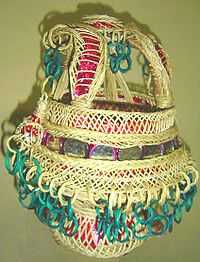Kanger

A kanger (Kashmiri: कांगर (Devanagari), کانگر (Nastaleeq); also known as kangri or kangar or kangir)[1] is an pot filled with hot embers used by Kashmiris beneath their traditional clothing to keep the chill at bay,[2] which is also regarded as a work of art.[3] It is normally kept inside the phiren (Overcoat type garment), the Kashmiri cloak,[4] or inside a blanket.[5] If a person is wearing a jacket, it may be used as a hand-warmer.[6] It is about 6 inches (150 mm) in diameter and reaches a temperature of about 150 °F (66 °C).[7]
Background
After the earthen pots are moulded, these are sold to the artisans who complete the wickerwork around them,[8] erect two arms to handle the pot, and colour it to give an aesthetically delicate shape.[9] The final product then goes to the market. It is generally believed that Kashmiris learnt the use of the Kangri from the Italians who were in the retinue of the Mughal emperors, and usually visited the Valley during summer.[10] In Italy (where a similar device was known as a scaldino)[11] and Spain braziers were made in a great variety of shapes and were profusely ornamented. Historical data, however, contradicts the claim that kangri has come to Kashmir from Italy, but it is known that it was used in the time of the Mughal Empire.[12] Those visiting Kashmir for the first time during the winter season are surprised to find people carrying firepots in their hands or in their laps[13] but every Kashmiri knows how to handle the apparatus with care. Kashmiri Pandits burn Kangri's on the occasion of a local festival called Teela Aetham, marking the end of winter season.[14] Isband, aromatic seeds believed to shove away negative energies, are burnt in a kanger to mark a good beginning to a party.[15]
Legacy
This Kashmiri proverb, "what Laila was on Majnun’s bosom (Legendary Lovers), so is the Kanger to a Kashmiri", sums up the relationship between a Kashmiri and the Kanger and its cultural importance, which is also shown by this verse:[13]
- Ai kangri! ai kangri!
- Kurban tu Hour wu Peri!
- Chun dur bughul mi girimut
- Durd az dil mi buree.
- (Oh, kangri! oh, kangri!
- You are the gift of Houris and Fairies;
- When I take you under my arm
- You drive fear from my heart.)
Medical hazards
Regular use of the kanger can cause a specific skin cancer known as kangri cancer.[16] This effect was first studied by W. J. Elmslie in 1866 and was thought to be caused by burns,[5] but it is now thought to be the result of a carcinogenic distillation product of woodcoal.[7]
References
- ↑ Khan, Mohammad Ishaq (1978). History of Srinagar, 1846-1947. Aamir Publications. p. 85. OCLC 5220131.
- ↑ Qadri, M. Afzal; G̲h̲ain He Gūrkū (1997). Cultural Heritage of Kashmir. University of Kashmir. p. 31. OCLC 39292540.
- ↑ Raina, A. N. (1981). Geography of Jammu and Kashmir. National Book Trust. p. 144. OCLC 9260048.
- ↑ Hueper, Wilhelm C. (1942). Occupational Tumors and Allied Diseases. C. C. Thomas. p. 293. OCLC 5639833.
- ↑ 5.0 5.1 Mayer, Ishtiaq Ahmad (2007). Medical Geography. APH Publishing. p. 24. ISBN 978-81-313-0268-2.
- ↑ Isaac, John; Art Davidson (2008). Vale of Kashmir. W. W. Norton. p. 75. ISBN 978-0-393-06525-1.
- ↑ 7.0 7.1 National Research Council (U.S.). Committee on Biologic Effects of Atmospheric Pollutants (1972). Particulate Polycyclic Organic Matter. National Academy of Sciences. p. 193. ISBN 978-0-309-02027-5.
- ↑ Murray-Aynsley, Harriet Georgiana Maria Manners-Sutton; George Christopher Molesworth Birdwood (1900). Symbolism of the East and West. Redway. p. 208. OCLC 60177010.
- ↑ Singh, Kumar Suresh (1993). Basketry in India. Ministry of Human Resource Development (India). p. 28. OCLC 30361817.
- ↑ India Quarter Master General's Dept. (1991). Gazetteer of Kashmir and Ladak. Sang-e-Meel Publications. p. 476. ISBN 978-969-35-0104-9.
- ↑ MacGregor, Charles Metcalfe; F. Maisey, Charles Ellison Bates (1995). Central Asia. Barbican. p. 38. ISBN 978-1-900056-30-4.
- ↑ Mattoo, A. Majid (1988). Kashmir under the Mughals, 1586-1752. Golden Horde Enterprises. p. 137. OCLC 19811895.
- ↑ 13.0 13.1 Vigne, G. T. (1844). Travels in Kashmir, Ladak, Iskardo, the Countries Adjoining the Mountain-course of the Indus, and the Himalaya, North of the Panjab ...: With Map. Henry Colburn. p. 317. OCLC 5970833.
- ↑ T.N. Dhar. "The Festivals of the Kashmiri Pandits".
- ↑ Rajesh Bhat (2 december 2007). "Warm up to kangri".
- ↑ Raven, Ronald William (1957). Cancer. Butterworth. p. 277. OCLC 2730378.